Reducing our dependence on foreign oil means looking at alternatives for all kinds of products that use oil as an ingredient – like tires, for example.
 Wood science researchers at Oregon State University have found that microcrystalline cellulose, which can be made easily from almost any type of plant fibers, could replace silica as a reinforcing filler in the manufacture of rubber tires.
Wood science researchers at Oregon State University have found that microcrystalline cellulose, which can be made easily from almost any type of plant fibers, could replace silica as a reinforcing filler in the manufacture of rubber tires.
Cellulose fiber has been used for some time as reinforcement in some types of rubber and automotive products, such as belts, hoses and insulation – but never in tires, where the preferred fillers are carbon black and silica. Carbon black, however, is made from increasingly expensive oil, and the processing of silica is energy-intensive. Both products are very dense and reduce the fuel efficiency of automobiles.
In the search for new types of reinforcing fillers that are inexpensive, easily available, light and renewable, OSU experts turned to microcrystalline cellulose – a micrometer-sized type of crystalline cellulose with an extremely well-organized structure. It is produced in a low-cost process of acid hydrolysis using nature’s most abundant and sustainable natural polymer – cellulose – that comprises about 40-50 percent of wood.
In this study, OSU researchers replaced up to about 12 percent of the silica used in conventional tire manufacture. This decreased the amount of energy needed to compound the rubber composite, improved the heat resistance of the product, and retained tensile strength.
Traction is always a key issue with tire performance, and the study showed that the traction of the new product was comparable to existing rubber tire technology in a wet, rainy environment. However, at high temperatures such as in summer, the partial replacement of silica decreased the rolling resistance of the product, which would improve fuel efficiency of rubber tires made with the new approach.

